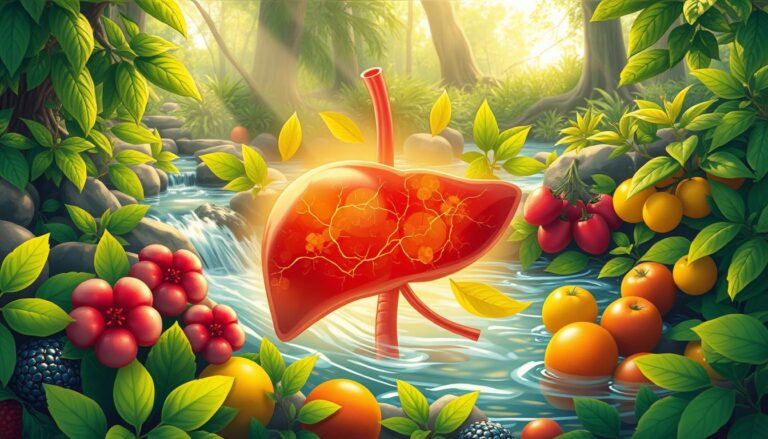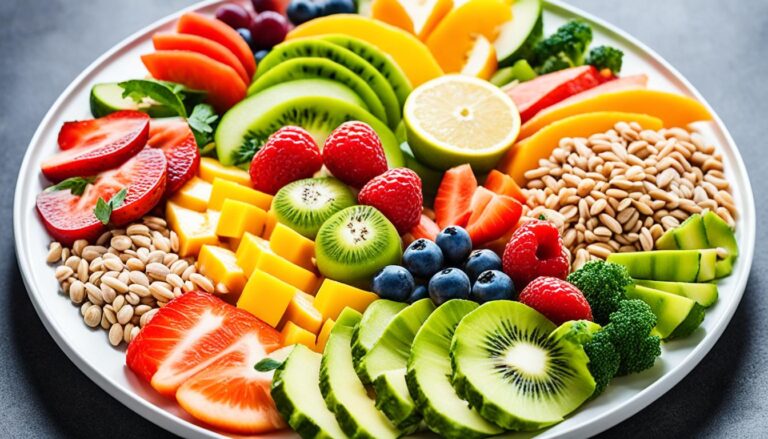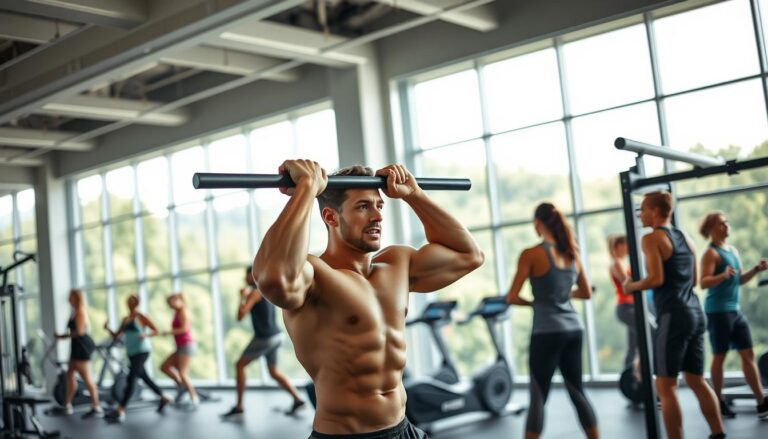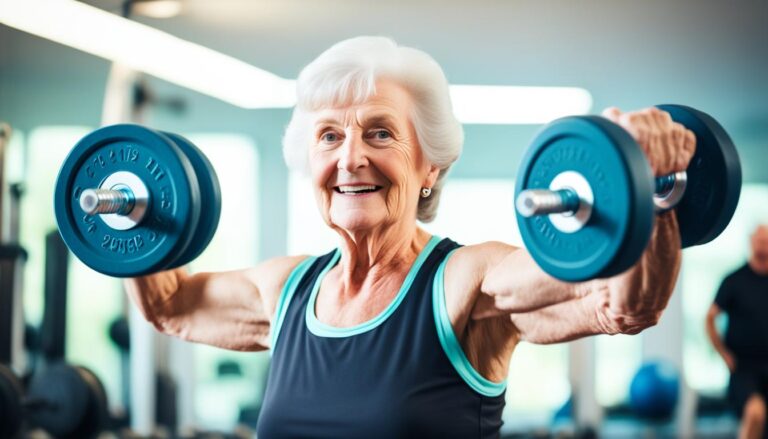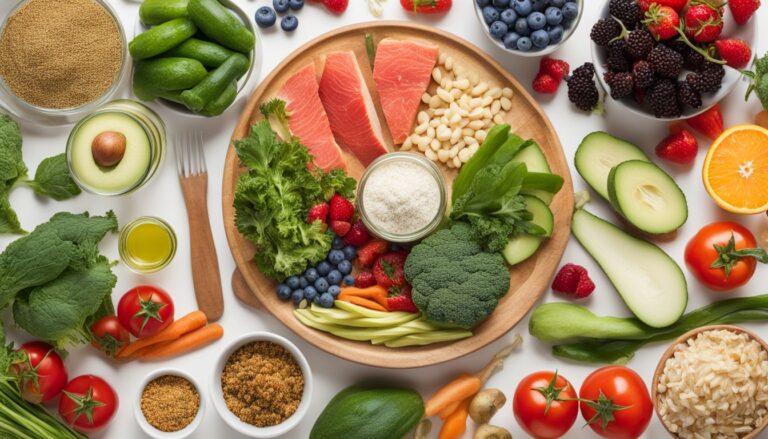Are you tired of trying one fad diet after another, only to see the weight creep back on? If so you’re not alone. Lasting weight loss needs a full plan that covers nutrition and exercise. But what’s the best way to lose weight safely and effectively?
Losing weight means burning more calories than you eat. Eating well and exercising regularly including cardio and strength training helps you do this. Studies show exercise is key for weight loss. It boosts your metabolism and burns fat.
Key Takeaways
- Achieving a calorie deficit is the key to weight loss
- Combining a healthy diet with regular exercise is essential for effective and sustainable weight loss
- Cardio, strength training, and interval training can all contribute to fat burning and weight loss
- Aim for at least 300 minutes of moderate-intensity exercise per week for optimal weight loss results
- Losing weight gradually, at a rate of 1-2 pounds per week, is recommended for long-term success
What is the Best Routine to Lose Weight?
Losing weight means you need to burn more calories than you eat. Eating well and exercising regularly helps you do this. Good exercise can speed up weight loss. But, keeping healthy habits for a long time is key.
This includes eating a variety of foods, drinking water, and getting enough sleep. Managing stress is also important.
To make a weight loss plan that lasts, try these tips:
- Do at least 300 minutes of activity each week, like brisk walking or cycling.
- Try HIIT exercises to keep burning fat for up to 24 hours after working out.
- Do strength training 3-5 times a week to build muscle and boost your metabolism.
- Combine aerobic exercise with activities like yoga or swimming to improve fitness and well-being.
Remember, losing weight is a long-term journey, not a quick fix. Slow, steady changes in your diet and exercise can help you reach your goals. And keep you healthy for life.
Losing weight requires a calorie deficit, where you burn more calories than you consume. Combining a nutritious diet and regular exercise can help achieve this calorie deficit.
The Importance of Tracking Your Weight
Tracking your weight is a powerful tool for losing weight. Weighing yourself in the morning, after using the restroom, gives the most accurate reading. Seeing your weight each day can keep you motivated and on track with your diet.
It’s important to be consistent when weighing yourself. Variables like what you wear the time of day, and the scale type should stay the same. Weighing yourself at the same time every day, like in the morning helps track weight changes and trends.
Tracking other health metrics like body fat percentage and waist measurement can give a fuller picture of your health. Smart scales that measure these can be very helpful in your weight loss journey.
Some people prefer weighing themselves daily while others do it less often like once a week. Weighing less often can help you avoid getting discouraged by small daily changes. It helps you focus on your overall weight loss journey.

The scale is just one tool to track your progress. Combining regular weigh-ins with how your clothes fit and how you feel gives a better understanding of your weight loss. Being consistent and patient is key to reaching your weight loss goals.
Hydrate Before Meals
Staying hydrated is key for good health and weight loss. Drinking water before meals is a simple way to help manage your weight.
Studies show drinking 200-250 milliliters of warm water after meals can help you lose weight. A 2013 study found drinking one extra cup of water a day can prevent weight gain. Swapping sugary drinks for water can also help you lose 1.1 pounds over four years.
A 2019 review found drinking more water can lead to weight loss of 0.4 to 8.8 kg. The goal is to drink 2 liters a day, or eight 8-ounce glasses. But, your needs may vary based on age, activity, and health.
Drinking water before meals can make you feel full, helping you eat fewer calories. A 2018 study showed water works best for those of average weight and BMI.
Water fasting can lead to quick weight loss but is not safe or sustainable. Instead, drink more water by carrying a bottle, eating water-rich foods, and staying hydrated before, during, and after exercise.
Drinking water before meals can lead to a feeling of fullness, reducing hunger and unnecessary snacking.
By prioritizing hydration, you can aid in weight loss, boost metabolism, and enhance overall health. Make drinking water a daily habit and see the positive effects on your well-being.
Exercise Before Breakfast
Doing moderate exercise before breakfast can help burn more body fat. This method can make your workouts more effective. It lets your body use fat for energy when you’re hungry.
Research shows exercising before breakfast can increase fat burning by up to 20 percent. This is because your body uses fat for energy when you’re not eating. It depletes glycogen stores overnight, making fat a better fuel source in the morning.
But, this method isn’t for everyone. Some people might feel nauseous or dizzy from fasting workouts. It’s best to keep these workouts short, under 60 minutes, to avoid risks.
If you’re trying to build muscle, a small, protein-rich snack before working out might be better. It helps with energy and muscle recovery. The best time to eat depends on your fitness goals and what you prefer.

A study found obese or overweight men burned twice as much fat exercising before breakfast. They also improved their insulin sensitivity. This can lower the risk of type 2 diabetes and heart disease.
Choosing to exercise before or after breakfast depends on your goals and how your body reacts. Try both and see what works best for you. This way, you can boost your metabolism and burn more fat.
Prioritize Protein
Adding protein-rich foods to your diet can change the game for weight loss. Protein keeps you full longer and boosts your metabolism. Your body uses more calories to digest protein than carbs or fats, making it key for losing weight.
The Dietary Guidelines for Americans 2020–2025 say adult men need at least 56 grams of protein a day. Women should aim for 46 grams. Eating up to 2 g/kg/bw of protein daily can help build strength and prevent muscle loss. A diet rich in protein, about 1.34 g/kg/bw, can lead to more weight loss than the RDA suggests.
Experts say you should eat 1.2–2 g/kg/bw or 0.6–0.9 g/lbs/bw of protein daily. For someone weighing 68 kg 150 lbs, that’s 82–136 grams of protein. High protein diets are safe for most people and don’t harm the kidneys if you have normal kidney function.
Eating foods high in protein like meats, fish eggs dairy, and legumes can help you meet your protein needs. If you’re having trouble getting enough protein try adding a high quality whey protein powder to your diet. By focusing on protein you can feel fuller speed up your metabolism, and aid in your weight loss journey.
Consuming protein-rich foods can help you feel fuller for longer and increase your metabolism, as your body burns more calories to break down protein than it does for carbs or fat.
Plan Your Meals
Planning your meals ahead can really help you lose weight. It lets you choose healthier options and avoid junk food. With a plan, you won’t grab unhealthy snacks when you’re hungry.
Meal planning has many benefits:
- It helps you keep your calorie intake low for weight loss.
- It makes you focus on eating foods that are good for you and keep you full.
- It saves time and reduces stress by solving the what’s for dinner? problem.
- It makes it easier to stick to your plan by letting you prepare meals in advance.
To succeed with meal planning, look at your week and plan for meals and snacks. Create a menu that includes lots of protein, fiber, and nutrients. The goal is to find a balance that fits your life and tastes.
| Meal | Healthy Choice | Calories |
|---|---|---|
| Breakfast | Oatmeal with berries and nuts | 350 |
| Snack | Greek yogurt with sliced apples | 200 |
| Lunch | Grilled salmon, roasted sweet potatoes, and steamed broccoli | 450 |
| Snack | Carrot sticks with hummus | 150 |
| Dinner | Baked chicken, quinoa, and roasted vegetables | 450 |
Remember, meal planning is personal. Try different ways until you find what works for you. With practice, you’ll make better food choices and reach your weight loss goals.

Get Some Morning Sunlight
Getting some morning sunlight can help with weight loss. Studies show that people who get sunlight early in the day tend to weigh less. This is compared to those who go out later.
A study with 54 adults found a link between sunlight and lower BMI. Those exposed to bright light showed the strongest connection. It’s thought that 20 to 30 minutes of morning light can affect body weight.
While the exact link between morning light and weight is still being studied, the evidence is strong. Researchers are looking into how light exposure can help manage weight. This is part of growing interest in using light to improve health.
Morning sunlight also helps with sleep and feeling refreshed. It helps set healthy circadian rhythms. This affects hormone production and sleep patterns.
So, if you want to boost your weight loss, try getting some morning sunlight. Even a short walk or time outside can improve your health.
Exposure to bright light in the morning or early afternoon, combined with Vitamin D supplementation, may positively affect weight metabolism, and overall well being.
The link between morning light and weight is still being studied. But, the research shows it’s a natural and simple way to help with health goals.
Measure Portions
Controlling portion sizes is key to losing weight and keeping it off. Using measuring cups and spoons helps avoid too much food. This ensures you eat the right amount of calories for your goals.
It’s easy to eat more than we think, especially when eating out or snacking from big packages. Big portions can lead to eating too many calories. By measuring your food, you can know exactly how many calories you’re eating. This helps you make better diet choices.
Visual Cues for Portion Control
Measuring tools aren’t the only way to control portions. Visual cues can also help. For example:
- A serving of fruit should be about the size of a tennis ball.
- A serving of vegetables should be the size of a baseball.
- A serving of carbohydrates, such as whole-grain pasta or bread, should be the size of a deck of cards.
- A serving of protein, like a piece of chicken or a vegetarian burger, should be about the size of a deck of cards.
- A serving of healthy fats such as butter or mayonnaise, should be the size of a pair of dice.
Knowing these visual cues helps guess portion sizes when you don’t have measuring tools.
The Importance of Portion Control
Controlling portions is vital for managing weight and calories. Studies show we eat more with bigger portions, even if we’re not hungry. Being mindful of portion sizes helps meet nutritional needs without going over daily calorie limits.
For lasting weight loss, find a balanced approach that fits you. Using measuring tools and visual cues is a great strategy for your weight-loss journey.
Practice Mindful Eating
Mindful eating is a great way to manage weight and feel better overall. It teaches us to enjoy our food more by slowing down and paying attention. This makes eating more meaningful and satisfying.
One big plus of mindful eating is it helps control calorie intake. By noticing what we eat, we eat less mindlessly. This can prevent weight gain. It also helps us listen to our body’s hunger and fullness signals, making it easier to stop eating when we’re full.
- Mindful eating helps us see food in a positive light, improving our eating habits.
- It trains our brain to focus more during meals.
- It makes us appreciate our food more, feeling grateful for our meals.
- Studies show it can be as good for weight loss as traditional diets.
Adding mindful eating to our daily lives can help us lose weight. It also helps us have a better relationship with food and feel more positive about ourselves.
Mindful eating is about being fully present in the moment while you eat, being aware of your senses, your body, and your emotions. It’s about savoring each bite and truly appreciating the nourishment your food provides. – Registered Dietitian Kimberly Gomer
In the end, mindful eating is a powerful tool for weight loss and a healthier relationship with food. By enjoying our meals more, we get many benefits from this practice.
Watch Your Juice Intake
Fruit juices can add vitamins and minerals to your diet. But, they often have a lot of sugar and calories. Many juices have added sugars, which can lead to too many calories and hinder weight loss.
To keep your juice intake healthy, follow these tips:
- Opt for small glass sizes. A typical 8-ounce serving of fruit juice can have up to 24 grams of sugar and 120 calories. Try to stick to 4-6 ounce portions to control your calorie and sugar intake.
- Choose lower sugar options. Vegetable juices, like those made from kale spinach or beets, have fewer calories and less sugar than fruit juices.
- Dilute your juice with water. This can lower the calorie and sugar content while keeping the flavor.
- Prioritize whole fruits over juices. Eating whole fruits gives you more fiber. This can make you feel fuller and more satisfied, helping with portion control.
By being careful with your juice intake and picking lower-sugar options, you can get the good stuff from juices without ruining your weight loss plans.
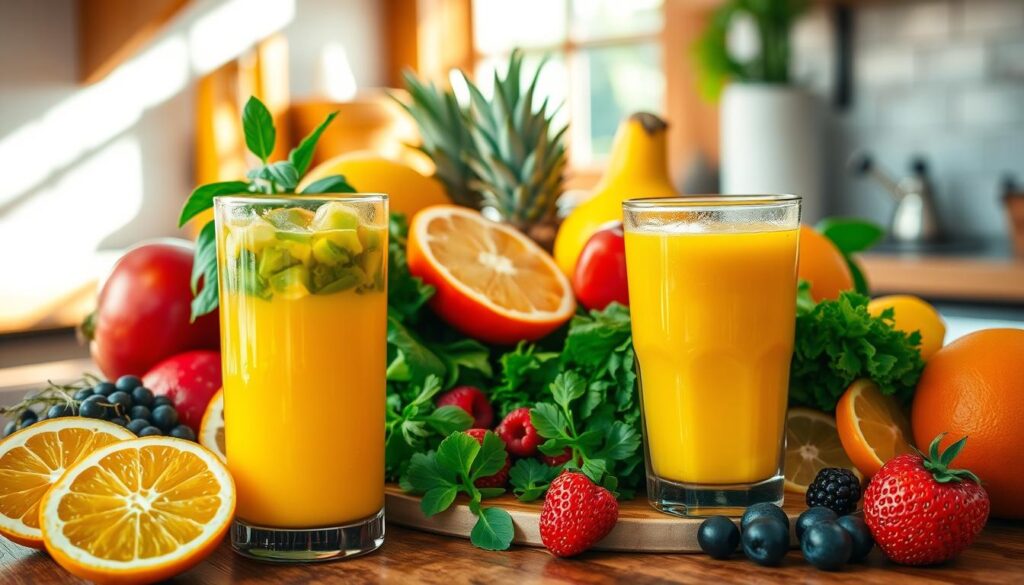
Limit Sugary Drinks
Specialty coffees, sodas, and other sugary drinks can add hundreds of calories daily. These drinks are a big part of the sugar in our diet. About 30% of Americans over 2 years old eat too much sugar.
A 12-ounce regular soda has over 10 teaspoons of sugar, which is 150 calories. Cutting out two sodas a day can save 2,100 calories a week. The Dietary Guidelines say to limit added sugars to less than 10% of your daily calories. For kids under 2, it’s best to have no added sugar at all.
Opt for Lower-Calorie Alternatives
Instead of sugary drinks, try these low calorie alternatives:
- Plain or unsweetened flavored water
- Unsweetened tea
- Hot or iced coffee
- 100% fruit or vegetable juice
- Whole fruit
Switching to these options can cut down on calories from sugary drinks. Remember, many foods have added sugars. Always check the labels and choose foods with less sugar.
Reducing sugar intake by eliminating two regular sodas per day can lower overall calorie intake.
| Beverage | Calories | Added Sugars grams |
|---|---|---|
| 12-oz Regular Soda | 150 | 39 |
| 12-oz Energy Drink | 160 | 54 |
| 16-oz Sweetened Iced Tea | 180 | 46 |
| 16-oz Flavored Latte | 240 | 31 |
Pack Healthy Snacks and Meals
Packing healthy snacks and meals helps you avoid unhealthy choices when you’re hungry. This simple trick can help you keep your calorie intake in check. It also makes it easier to stay on track with your weight loss plan.
The Benefits of Packing Healthy Snacks and Meals
Studies show that eating more often can help manage hunger and improve blood sugar levels. Packing snacks and meals rich in nutrients offers many benefits:
- Nuts, like almonds, are full of healthy fats, protein, and fiber. They can help with weight loss when eaten in moderation.
- Greek yogurt with fresh berries is a protein-packed snack that’s also rich in antioxidants.
- Cottage cheese with fruit is a sweet, creamy snack that’s filling and has 25 grams of protein per cup.
- A mix of kale and olive oil is a balanced snack full of fiber, antioxidants, and minerals.
- Dark chocolate and almonds together offer antioxidants and healthy fats for a satisfying treat.
Other healthy snack options include eggs, carrots with dressing, cheese and crackers, beef jerky, protein smoothies, and canned fish on whole wheat toast.
| Snack | Nutritional Benefits |
|---|---|
| Edamame | Fiber-rich, complete plant-based protein |
| Oatmeal | High in protein, fiber, and complex carbs |
| Pear and Ricotta Cheese | Sweet, creamy snack rich in fiber and protein |
| Homemade Trail Mix | Fiber, protein, and healthy fats from dried fruit and nuts |
| Turkey Roll-ups | High-quality protein for satiety and weight management |
By packing a variety of healthy snacks and healthy meals, you can better manage your hunger. This supports your meal prep and weight loss goals.
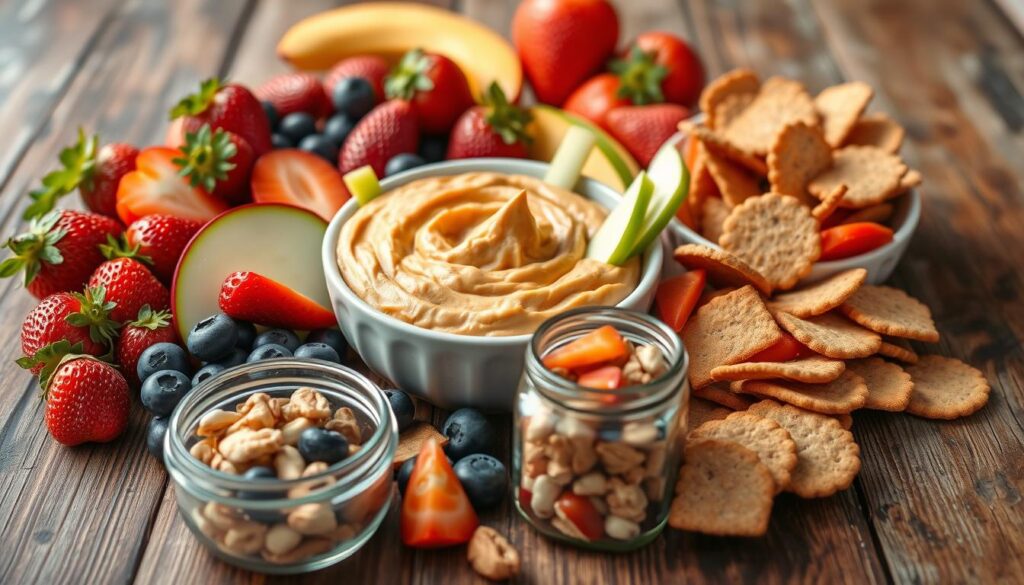
Conclusion
For lasting weight loss, you need a plan that includes a diet low in calories, regular exercise, and changes in your lifestyle. The best way to lose weight is to mix several key strategies. These include tracking your weight, drinking plenty of water, and exercising in the morning.
Also, make sure to eat enough protein, plan your meals, and get sunlight in the morning. Control your food portions, eat mindfully, and avoid sugary drinks and juices. These habits can help you lose weight and feel better overall.
By sticking to these healthy habits, you can see real changes in your body and health. Remember, losing weight is a journey, not just a goal. With the right mindset and effort, you can reach your goals and stay healthy for years.
The statistics in this article show a clear path to managing your weight. They cover everything from daily fiber and exercise needs to the right calorie intake and weight loss goals. Following these tips can help you succeed in your weight loss journey. It will also bring you many health benefits.
